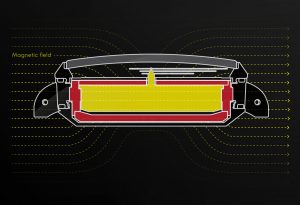Technical
Agents Of SHIELD: An Antimagnetism Primer
It’s safe to say that magnetism is just one of those things — like gravity and friction — that gets taken for granted even though it fundamentally defines every aspect of our lives. The principles of magnetism are at work in the vast legions of electronic equipment that surround us. They are also present at the core of the earth, resulting in the magnetic poles and magnetosphere.
Earth’s magnetosphere — far from being Ian McKellen’s secret lair where he sits wearing his purple helmet plotting the subjugation of all humankind — is what deflects solar winds and stops vast radioactive waves from entering our planet’s atmosphere, essentially protecting us from being turned into walking Hot Pockets. Most people would agree it’s pretty necessary.
Amusingly enough, being bombarded with irradiated particles spit out by the sun is exactly the kind of thing that would turn us all into mutants (though most likely not cool ones with cool powers), which seems like something Magneto would be into. Magneto would probably disapprove of the magnetosphere, since it goes against his aim of catalysing the ascendancy of the mutant race on earth. The Anti-Magneto-sphere, you might call it.
Magnetism also affects the way our watches run. If your timepiece is running inexplicably fast, chances are it’s been magnetised. This is by far the most common issue seen at watch service centres. Not many people realise how easy it is to magnetise a watch — even resting it on an iPad can create a noticeable effect in some timepieces.
When a watch has been magnetised, the magnetic domains in the ferromagnetic components of the watch are aligned. The coils of the hairspring become magnetically attracted to each other, for example. This effectively speeds up the oscillation of the balance, since the hairspring is restricted in its breathing, and the watch runs fast.
Such a watch requires degaussing before it can run accurately again. The degaussing process involves passing the watch in question through varying magnetic fields until its magnetic domains become randomized again.

One common way of shielding a watch movement from magnetism is to encase it in a soft-iron cage, indicated by the red section of the diagram (Image courtesy of Omega)
An anti-magnetic watch is one that has been built to resist being magnetised. Components which directly relate to the chronometric qualities of a watch, such as the hairspring and balance, should be made of amagnetic materials. Most modern watches already have this in place — the vast majority of them bearing Nivarox hairsprings, which are made from an alloy resistant to magnetism.
Not every single component of a watch has to be amagnetic in order to conform to the official standards (ISO 764) of an anti-magnetic watch. To achieve this rating, a watch is exposed to a magnetic field of 4,800 A/m, and its post-exposure timing must deviate from its pre-exposure timing by less than 30 seconds per day.
Additionally, some watches include a soft-iron cage between watch case and watch movement, which provides a preferential pathway for magnetic forces, thus shielding the movement.
If you work with a lot of electronic equipment — as many of us do in this day and age — it’s worth taking the time to find out exactly how your watch will stand up to the environment you’re in.











